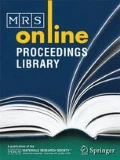Abstract
57Fe Mössbauer spectroscopy has been used to study the environment and oxidation state of iron in a series of vitrified sewage sludge ash (SSA) wastes, which are broadly similar in composition and variability to some intermediate-level legacy wastes (ILLW). The SSA wastes studied here are incapable of forming an homogeneous glass when melted at 1450 °C although increasing additions of CaO reduce the crystalline content, which consists of Ca3(PO4)2 and Ca3Mg3(PO4)4. Bulk glass transition temperatures of 670–850 °C have been measured, the value decreasing with increasing CaO content. Tetrahedrally coordinated Fe3+ appears to exist in vitrified SSA only at high CaO contents (> ∼ 29 mol. %) and whilst broadly similar to our previous results for simulated vitrified SSA, behavioural differences have been noted between fitted Mossbauer parameters for real and simulated vitrified SSA. We suggest that these could be attributable to the buffering action of carbon and other reducing agents in the real SSA wastes.
Similar content being viewed by others
References
I.W. Donald, B.L. Metcalfe and R.N.J. Taylor, J. Mater. Sci. 32, 5851 (1997).
P.A. Bingham and R.J. Hand, J. Appl. Ceram. 100, 120 (2001).
Chancellor’s Pre budget report 2002. http://www.hmtreasury.gov.uk/pre_budget_report/prebud_pbr02/report/prebud_pbr02_repchap7.cfm
Landfill directive briefing paper, Defra, UK. http://www.defra.gov.uk/environment/waste/topics/landfill-dir/pdf/landfilldir.pdf
B.O. Mysen, D. Virgo and F.A. Seifert, Amer. Mineral. 69, 834 (1984).
M. B. Volf, Chemical Approach to Glass, Elsevier, Amsterdam, 1984.
M. D. Dyar, Amer. Mineral. 70, 304 (1985).
G. Tomandl, in Glass: Science and Technology, 4B Ed. D.R. Uhlmann, N.J. Kreidl, Academic Press, New York, 1990, ch. 5.
RECOIL v.1.05, Intelligent Scientific Applications Inc., Ottowa, Canada.
S.H. Kilcoyne, D. Greig and M.N. Gona, Hyperfine Interact. 165, 167 (2005).
J. A. Duffy, J. Non-Cryst. Solids 297 (2002). 275.
C. Rüssel and A. Wiedenroth, Chem. Geol. 213, 125 (2004).
E. Antoni, L. Montagne, S. Daviero, G. Palavit, J. L. Bernard, A. Wattiaux and H. Vezin, J. Non-Cryst. Solids 345&346, 66 (2004).
O.M. Hannant, P.A. Bingham, S.D. Forder and R.J. Hand, Phys. Chem. Glasses: Eur. J. Glass Sci. Technol. B 48 (2007). (in press).
O.M. Hannant, P.A. Bingham, S.D. Forder and R.J. Hand, Proc. XXIst Int. Congr. Glass, Strasbourg, France (2007), CD-ROM paper U30.
I. Merino, L.F. Arevalo and F. Romero, Waste Man. 25, 1046 (2005).
Author information
Authors and Affiliations
Rights and permissions
About this article
Cite this article
Oliver, M.H., Paul, A.B., Russell, J.H. et al. A Mössbauer Study of Iron in Vitrified Wastes. MRS Online Proceedings Library 1107, 215 (2008). https://doi.org/10.1557/PROC-1107-215
Published:
DOI: https://doi.org/10.1557/PROC-1107-215




